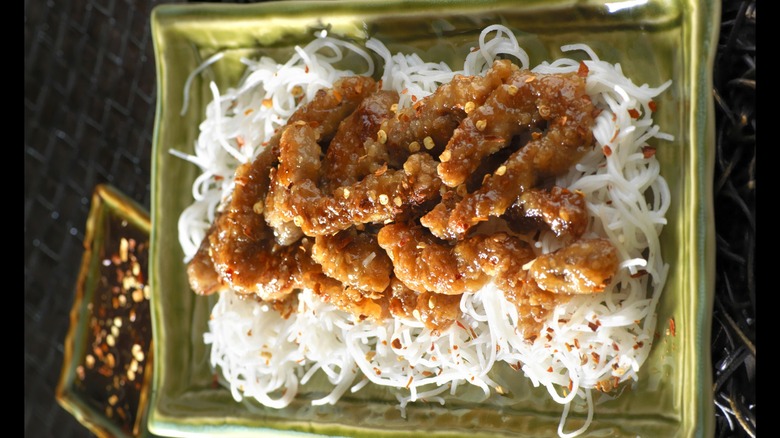How Ginger Beef Became A Staple Of Chinese Canadian Cuisine
When modern foodies hear the words "fusion cuisine," Korean American or Tex Mex might come to mind. But, what about Chinese Canadian? To ginger beef fans, it's all about this gastronomic gem. If you've never tried it before, ginger beef is made from strips of beef that are coated in batter, deep-fried, and slathered in a sticky, sweet and spicy chili-ginger-garlic sauce similar to General Tso's sauce. The flavored beef gets stir-fried with a host of veggies, and the whole thing is served over a bed of white rice. (Noodles are less common, but not unheard of.) The batter makes for beef with a tender, juicy interior and crispy exterior. Bell peppers, onions, and carrots are common ingredients, and strips of punchy fresh ginger are often thrown into the mix too.
Per the lore, Chinese Canadian ginger beef was created by chef George Wong at the Silver Inn in Calgary. The Beijing-style restaurant was opened in 1975 by Wong's wife Lily and her sister Louise Tsang, and the kitchen was run by the chef. He crafted the dish to be a small plate bar snack that would boost alcohol sales for the restaurant. Ginger beef was intended to be a fusion of two foods already popular in Alberta: french fries and beef. Wong fried the beef as you would french fries and the sticky sour sauce was inspired by ketchup. The avant-garde adaptation hit the menu sometime during the 1970s, and the rest is history.
The beginning of an era led by comfort food
Today, ginger beef is served at restaurants, food trucks, and mall food courts from Alberta to British Columbia to Nova Scotia. It's especially a mainstay in Calgary's Chinatown, where it isn't uncommon for restaurants to prep 150 servings of the dish on a busy night. At face value, it's a combination of Chinese culinary styles and Western ingredients. But, in many ways, ginger beef is a symbol of Chinese immigrants establishing communities in North America.
Foodies from the Chinese province of Guangdong who arrived during the 1850s brought with them the crave-able style of Cantonese cooking. As these immigrants opened restaurants, they needed to craft accessible dishes that would appeal both to other immigrants with similar palates and unaccustomed Canadian diners. Many now-popular Chinese North American dishes emerged from this time, including mu shu pork and chop suey, but ginger beef found a permanent home in Canada.
For contemporary foodies, this reverence for the intersection of cultural heritage and evolution has inspired the emergence of the "New Asian" culinary movement, which combines traditional dishes with modern techniques. As for the Silver Inn, it remained so beloved by the local community for 47 years that the day after it finally closed, the restaurant's sign was stolen (and later returned).

